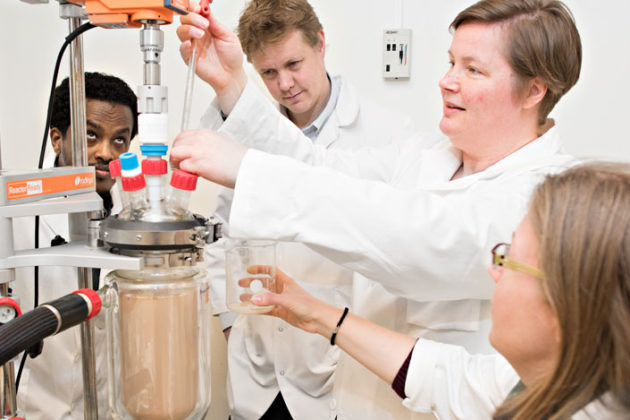From lab to industrial scale

Over a number of years, Nofima scientists have developed methods for better utilising residual raw materials. This research is now taking the giant leap into the industry.
At Nortura in Hærland, chicken and turkey carcasses are transported in a pipe from the cut-up line directly to a separate residual raw material line. At Biomega on the outskirts of Bergen, residual raw materials from salmon are processed, such as their heads, skins and bones. Enzymatic hydrolysis process lines have been installed at both of these facilities. The residual raw materials are ground before undergoing a hydrolysis process. It is in this hydrolysis process where Nofima’s research will come in useful.
There are often large chemical variations in the residual raw material used in the processes. In addition, the residual raw materials contain many different chemical components. The aim is that sensor technology, such as NIR (Near- Infrared) spectroscopy, will make it possible to control the quality of the residual raw material, the quality of the product and what takes place during processing
“From work that has taken place in the laboratory, we know a little about which parameters we can use to achieve the desired quality of hydrolysates, and the next step is to investigate what needs to be done in order for this to work in the industry. We are going to use spectroscopy and other methods of analysis to understand what is actually happening”, says Nofima scientist and head of the Smartbio project, Nils Kristian Afseth.
The salmon industry already has the hydrolysis system in place
Biomega, one of the project participants, has developed a hydrolysis process that is currently used on salmon. They have sent many kilograms of salmon bones, skins and heads to Nofima, which the scientists have used to calibrate the optimum parameters for NIR control. The aim is to gain better control over the quality of the final product through measuring the raw materials that are processed.

“Biomega is part of the Smartbio project to help develop tools that can provide us with better production control. This will then help us to standardise our process even better”, says Biomega’s Director of Research and Development, Bjørn Liaset.
Chicken and turkey carcasses will become valued products and ingredients
Chickens and turkeys are processed into various products at Hærland. The facility handles large volumes which means that considerable numbers of carcasses are produced every day. The aim is to develop these into valued products and ingredients.
Bioco is responsible for the new residual raw material production line at Hærland, a process that really involves pioneering work. The process of continuous enzymatic protein hydrolysis of chicken and turkey carcasses has never been tested on an industrial scale before.
“Bioco will contribute to a more sustainable poultry production, and in order to achieve this goal we must participate in projects that provide knowledge and help to optimise the process further. In this respect, we have high expectations for the Smartbio project”, says Bioco’s General Manager, Eirik Pallin
Consistent product quality is important
In the same way that the consistent quality of the meat products is important, the quality of the residual raw materials must also be stable. The hydrolysis process produces three different categories:
- Fat
- Protein hydrolysate (dissolved in water)
- Insoluble sediments such as protein, collagen and many different types of minerals.
Whether the fat is profitable or not is determined by where it comes from. For example, hydrolysate fats from salmon fetch a high price. However, the soluble protein and peptides offer the greatest economic growth potential in the future. Currently, much of this is used in the feed market, but if more of this can be utilised for human consumption, such as food ingredients, producers will achieve higher prices. It is therefore very important to produce products of consistent quality over time.
“We also further develop other types of spectroscopic analyses to measure protein composition in the raw materials. The aim is to gather data from raw material composition, process settings and product quality so that we understand the correlation between raw material variation and product quality. This understanding will allow us to produce stable product quality within the given specifications”, concludes Nils Kristian Afseth.
Fact Box – What is enzymatic protein hydrolysis?
Enzymatic protein hydrolysis is a process of splitting proteins with the help of enzymes and water. Long protein chains are broken down into small proteins called peptides and free amino acids. These are easier to digest and changes also occur in the functional properties.
Enzymatic hydrolysis also occurs in the human digestive system, for example. Pepsin, the digestive enzyme found in gastric juices, can also be used in industrial hydrolysis processes.
What is enzymatic protein hydrolysis?
Enzymatic protein hydrolysis is a process of splitting proteins with the help of enzymes and water. Long protein chains are broken down into small proteins called peptides and free amino acids. These are easier to digest and changes also occur in the functional properties.
Enzymatic hydrolysis also occurs in the human digestive system, for example. Pepsin, the digestive enzyme found in gastric juices, can also be used in industrial hydrolysis processes.
About the research
Smartbio is an innovation project owned by Bioco. Biomega and Nortura/Norilia also participate in the project. The project is funded by FFL and participating companies. Nofima is the only research institute working on the project.
Contact person
Research areas
